A Comprehensive Review: Materials for the Fabrication of Optical Fiber Refractometers Based on Lossy Mode Resonance
Abstract
1. Introduction
2. Basic Concepts
Setup Configurations
3. Coating Materials
3.1. Indium Tin Oxide (ITO)
3.2. Tin Oxide
3.3. Indium Oxide
3.4. Zinc Oxide
3.5. Titanium Dioxide
3.6. Polymers
3.7. Other Materials
4. Conclusions
Author Contributions
Funding
Conflicts of Interest
References
- Lazcka, O.; Del Campo, F.J.; Muñoz, F.X. Pathogen detection: A perspective of traditional methods and biosensors. Biosens. Bioelectron. 2007, 22, 1205–1217. [Google Scholar] [CrossRef] [PubMed]
- Fine, G.F.; Cavanagh, L.M.; Afonja, A.; Binions, R. Metal Oxide Semi-Conductor Gas Sensors in Environmental Monitoring. Sensors 2010, 10, 5469–5502. [Google Scholar] [CrossRef] [PubMed]
- Luppa, P.B.; Sokoll, L.J.; Chan, D.W. Immunosensors—Principles and applications to clinical chemistry. Clin. Chim. Acta 2001, 314, 1–26. [Google Scholar] [CrossRef]
- Mukhopadhyay, S.C. Wearable sensors for human activity monitoring: A review. IEEE Sens. J. 2015, 15, 1321–1330. [Google Scholar] [CrossRef]
- Homola, J. (Ed.) Surface Plasmon Resonance Based Sensors; Springer: Berlin/Heidelberg, Germany, 2006; Volume 4, ISBN 978-3-540-33918-2. [Google Scholar]
- Del Villar, I.; Hernaez, M.; Zamarreño, C.R.; Sánchez, P.; Fernández-Valdivielso, C.; Arregui, F.J.; Matias, I.R. Design rules for lossy mode resonance based sensors. Appl. Opt. 2012, 51, 4298. [Google Scholar] [CrossRef]
- Mishra, S.K.; Usha, S.P.; Gupta, B.D. A lossy mode resonance-based fiber optic hydrogen gas sensor for room temperature using coatings of ITO thin film and nanoparticles. Meas. Sci. Technol. 2016, 27. [Google Scholar] [CrossRef]
- Usha, S.P.; Gupta, B.D. Performance analysis of zinc oxide-implemented lossy mode resonance-based optical fiber refractive index sensor utilizing thin film/nanostructure. Appl. Opt. 2017, 56, 5716. [Google Scholar] [CrossRef]
- Sanchez, P.; Zamarreno, C.R.; Hernaez, M.; Del Villar, I.; Matias, I.R.; Arregui, F.J. Considerations for Lossy-Mode Resonance-Based Optical Fiber Sensor. IEEE Sens. J. 2013, 13, 1167–1171. [Google Scholar] [CrossRef]
- Kosiel, K.; Koba, M.; Masiewicz, M.; Śmietana, M. Tailoring properties of lossy-mode resonance optical fiber sensors with atomic layer deposition technique. Opt. Laser Technol. 2018, 102, 213–221. [Google Scholar] [CrossRef]
- Usha, S.P.; Mishra, S.K.; Gupta, B.D. Zinc oxide thin film/nanorods based lossy mode resonance hydrogen sulphide gas sensor. Mater. Res. Express 2015, 2. [Google Scholar] [CrossRef]
- Zubiate, P.; Zamarreño, C.R.; Del Villar, I.; Matias, I.R.; Arregui, F. Tunable optical fiber pH sensors based on TE and TM Lossy Mode Resonances (LMRs). Sens. Actuators B Chem. 2016, 231, 484–490. [Google Scholar] [CrossRef]
- Del Villar, I.; Arregui, F.J.; Zamarreño, C.R.; Corres, J.M.; Bariain, C.; Goicoechea, J.; Elosua, C.; Hernaez, M.; Rivero, P.J.; Socorro, A.B.; et al. Optical Sensors Based on Lossy-Mode Resonances; Elsevier B.V.: Amsterdam, The Netherlands, 2017; Volume 240, pp. 174–185. [Google Scholar]
- Vikas; Verma, R.K. Sensitivity enhancement of a lossy mode resonance based tapered fiber optic sensor with an optimum taper profile. J. Phys. D. Appl. Phys. 2018, 51, 415302. [Google Scholar] [CrossRef]
- Paliwal, N.; John, J. Theoretical modeling and investigations of AZO coated LMR based fiber optic tapered tip sensor utilizing an additional TiO2 layer for sensitivity enhancement. Sens. Actuators B Chem. 2017, 238, 1–8. [Google Scholar] [CrossRef]
- Arregui, F.J.; Del Villar, I.; Zamarreño, C.R.; Zubiate, P.; Matias, I.R. Giant sensitivity of optical fiber sensors by means of lossy mode resonance. Sens. Actuators B Chem. 2016, 232, 660–665. [Google Scholar] [CrossRef]
- Torres, V.; Beruete, M.; Sánchez, P.; Del Villar, I. Indium tin oxide refractometer in the visible and near infrared via lossy mode and surface plasmon resonances with Kretschmann configuration. Appl. Phys. Lett. 2016, 108, 043507. [Google Scholar] [CrossRef]
- Del Villar, I.; Zamarreño, C.R.; Hernaez, M.; Arregui, F.J.; Matias, I.R. Generation of Lossy Mode Resonances with Absorbing Thin-Films. J. Lightwave Technol. 2010, 28, 3351–3357. [Google Scholar] [CrossRef]
- Sanchez, P.; Zamarreño, C.R.; Hernaez, M.; Del Villar, I.; Fernandez-Valdivielso, C.; Matias, I.R.; Arregui, F.J. Lossy mode resonances toward the fabrication of optical fiber humidity sensors. Meas. Sci. Technol. 2012, 23, 014002. [Google Scholar] [CrossRef]
- Bogdanowicz, R.; Niedziałkowski, P.; Sobaszek, M.; Burnat, D.; Białobrzeska, W.; Cebula, Z.; Sezemsky, P.; Koba, M.; Stranak, V.; Ossowski, T.; et al. Optical Detection of Ketoprofen by Its Electropolymerization on an Indium Tin Oxide-Coated Optical Fiber Probe. Sensors 2018, 18, 1361. [Google Scholar] [CrossRef]
- Zubiate, P.; Zamarreño, C.R.; Sánchez, P.; Matias, I.R.; Arregui, F.J. High sensitive and selective C-reactive protein detection by means of lossy mode resonance based optical fiber devices. Biosens. Bioelectron. 2017, 93, 176–181. [Google Scholar] [CrossRef]
- Del Villar, I.; Torres, V.; Beruete, M. Experimental demonstration of lossy mode and surface plasmon resonance generation with Kretschmann configuration. Opt. Lett. 2015, 40, 4739. [Google Scholar] [CrossRef]
- Del Villar, I.; Zubiate, P.; Zamarreño, C.R.; Arregui, F.J.; Matias, I.R. Optimization in nanocoated D-shaped optical fiber sensors. Opt. Express 2017, 25, 10743. [Google Scholar] [CrossRef] [PubMed]
- Smietana, M.; Sobaszek, M.; Michalak, B.; Niedzialkowski, P.; Bialobrzeska, W.; Koba, M.; Sezemsky, P.; Stranak, V.; Karczewski, J.; Ossowski, T.; et al. Optical Monitoring of Electrochemical Processes With ITO-Based Lossy-Mode Resonance Optical Fiber Sensor Applied as an Electrode. J. Lightwave Technol. 2018, 36, 954–960. [Google Scholar] [CrossRef]
- Fuentes, O.; Goicoechea, J.; Corres, J.M.; Del Villar, I.; Ozcariz, A.; Matias, I.R. Generation of lossy mode resonances with different nanocoatings deposited on coverslips. Opt. Express 2020, 28, 288. [Google Scholar] [CrossRef] [PubMed]
- Fuentes, O.; Corres, J.M.; Matias, I.R.; Del Villar, I. Generation of Lossy Mode Resonances in Planar Waveguides toward Development of Humidity Sensors. J. Lightwave Technol. 2019, 37, 2300–2306. [Google Scholar] [CrossRef]
- Sanchez, P.; Zamarreno, C.R.; Arregui, F.J.; Matias, I.R. LMR-Based Optical Fiber Refractometers for Oil Degradation Sensing Applications in Synthetic Lubricant Oils. J. Lightwave Technol. 2016, 34, 4537–4542. [Google Scholar] [CrossRef]
- Zubiate, P.; Zamarreño, C.R.; Del Villar, I.; Matias, I.R.; Arregui, F.J.J. High sensitive refractometers based on lossy mode resonances (LMRs) supported by ITO coated D-shaped optical fibers. Opt. Express 2015, 23, 8045–8050. [Google Scholar] [CrossRef]
- Chiavaioli, F.; Zubiate, P.; Del Villar, I.; Zamarreño, C.R.; Giannetti, A.; Tombelli, S.; Trono, C.; Arregui, F.J.; Matias, I.R.; Baldini, F. Femtomolar Detection by Nanocoated Fiber Label-Free Biosensors. ACS Sens. 2018, 3, 936–943. [Google Scholar] [CrossRef]
- Niedziałkowski, P.; Białobrzeska, W.; Burnat, D.; Sezemsky, P.; Stranak, V.; Wulff, H.; Ossowski, T.; Bogdanowicz, R.; Koba, M.; Śmietana, M. Electrochemical performance of indium-tin-oxide-coated lossy-mode resonance optical fiber sensor. Sens. Actuators B Chem. 2019, 301, 127043. [Google Scholar] [CrossRef]
- Sobaszek, M.; Burnat, D.; Sezemsky, P.; Stranak, V.; Bogdanowicz, R.; Koba, M.; Siuzdak, K.; Śmietana, M. Enhancing electrochemical properties of an ITO-coated lossy-mode resonance optical fiber sensor by electrodeposition of PEDOT:PSS. Opt. Mater. Express 2019, 9, 3069. [Google Scholar] [CrossRef]
- Ozcariz, A.; Zamarreño, C.R.; Zubiate, P.; Arregui, F.J. Is there a frontier in sensitivity with Lossy mode resonance (LMR) based refractometers? Sci. Rep. 2017, 7, 10280. [Google Scholar] [CrossRef]
- Ascorbe, J.; Corres, J.M.; Matias, I.R.; Arregui, F. High sensitivity humidity sensor based on cladding-etched optical fiber and lossy mode resonances. Sens. Actuators B Chem. 2016, 233, 7–16. [Google Scholar] [CrossRef]
- Zubiate, P.; Urrutia, A.; Zamarreño, C.R.; Egea-Urra, J.; Fernández-Irigoyen, J.; Giannetti, A.; Baldini, F.; Díaz, S.; Matias, I.R.; Arregui, F.J.; et al. Fiber-based early diagnosis of venous thromboembolic disease by label-free D-dimer detection. Biosens. Bioelectron. X 2019, 2, 100026. [Google Scholar] [CrossRef]
- Wang, Q.; Li, X.; Zhao, W.-M.; Jin, S. Lossy mode resonance-based fiber optic sensor using layer-by-layer SnO2 thin film and SnO2 nanoparticles. Appl. Surf. Sci. 2019, 492, 374–381. [Google Scholar] [CrossRef]
- Sharma, S.; Gupta, B.D. Lossy Mode Resonance-Based Fiber Optic Sensor for the Detection of As (III) Using α-Fe2O3/SnO2 Core-Shell Nanostructures. IEEE Sens. J. 2018, 18, 7077–7084. [Google Scholar] [CrossRef]
- Hernaez, M.; Mayes, A.; Melendi-Espina, S. Graphene Oxide in Lossy Mode Resonance-Based Optical Fiber Sensors for Ethanol Detection. Sensors 2017, 18, 58. [Google Scholar] [CrossRef]
- Vicente, A.; Santano, D.; Zubiate, P.; Urrutia, A.; Del Villar, I.; Zamarreño, C.R. Lossy mode resonance sensors based on nanocoated multimode-coreless-multimode fibre. Sens. Actuators B Chem. 2020, 304, 126955. [Google Scholar] [CrossRef]
- Zamarreno, C.R.; Sanchez, P.; Hernaez, M.; Del Villar, I.; Fernandez-Valdivielso, C.; Matias, I.R.; Arregui, F.J. Sensing Properties of Indium Oxide Coated Optical Fiber Devices Based on Lossy Mode Resonances. IEEE Sens. J. 2012, 12, 151–155. [Google Scholar] [CrossRef]
- Fuentes, O.; Del Villar, I.; Corres, J.M.; Matias, I.R. Lossy mode resonance sensors based on lateral light incidence in nanocoated planar waveguides. Sci. Rep. 2019, 9, 8882. [Google Scholar] [CrossRef]
- Usha, S.P.; Mishra, S.K.; Gupta, B.D. Fiber optic hydrogen sulfide gas sensors utilizing ZnO thin film/ZnO nanoparticles: A comparison of surface plasmon resonance and lossy mode resonance. Sens. Actuators B Chem. 2015, 218, 196–204. [Google Scholar] [CrossRef]
- Paliwal, N.; Punjabi, N.; John, J.; Mukherji, S. Design and Fabrication of Lossy Mode Resonance Based U-Shaped Fiber Optic Refractometer Utilizing Dual Sensing Phenomenon. J. Lightwave Technol. 2016, 34, 4187–4194. [Google Scholar] [CrossRef]
- Usha, S.P.; Shrivastav, A.M.; Gupta, B.D. A contemporary approach for design and characterization of fiber-optic-cortisol sensor tailoring LMR and ZnO/PPY molecularly imprinted film. Biosens. Bioelectron. 2017, 87, 178–186. [Google Scholar] [CrossRef] [PubMed]
- Usha, S.P.; Gupta, B.D. Urinary p-cresol diagnosis using nanocomposite of ZnO/MoS2 and molecular imprinted polymer on optical fiber based lossy mode resonance sensor. Biosens. Bioelectron. 2018, 101, 135–145. [Google Scholar] [CrossRef] [PubMed]
- Paliwal, N.; John, J. Design and Modeling of Highly Sensitive Lossy Mode Resonance-Based Fiber-Optic Pressure Sensor. IEEE Sens. J. 2018, 18, 209–215. [Google Scholar] [CrossRef]
- Ozcariz, A.; Piña-Azamar, D.A.; Zamarreño, C.R.; Dominguez, R.; Arregui, F.J. Aluminum doped zinc oxide (AZO) coated optical fiber LMR refractometers—An experimental demonstration. Sens. Actuators B Chem. 2019, 281, 698–704. [Google Scholar] [CrossRef]
- Prieto-Cortés, P.; Álvarez-Tamayo, R.I.; García-Méndez, M.; Durán-Sánchez, M. Lossy Mode Resonance Generation on Sputtered Aluminum-Doped Zinc Oxide Thin Films Deposited on Multimode Optical Fiber Structures for Sensing Applications in the 1.55 µm Wavelength Range. Sensors 2019, 19, 4189. [Google Scholar] [CrossRef]
- Ozcariz, A.; Dominik, M.; Smietana, M.; Zamarreño, C.R.; Del Villar, I.; Arregui, F.J. Lossy mode resonance optical sensors based on indium-gallium-zinc oxide thin film. Sens. Actuators A Phys. 2019, 290, 20–27. [Google Scholar] [CrossRef]
- Hernáez, M.; Del Villar, I.; Zamarreño, C.R.; Arregui, F.J.; Matias, I.R. Optical fiber refractometers based on lossy mode resonances supported by TiO2 coatings. Appl. Opt. 2010, 49, 3980. [Google Scholar] [CrossRef]
- Zhao, W.M.; Wang, Q.; Wang, X.Z.; Li, X.; Jing, J.Y.; Sun, H.Z. Theoretical and experimental research of lossy mode resonance-based high-sensitivity optical fiber refractive index sensors. J. Opt. Soc. Am. B 2019, 36, 2069. [Google Scholar] [CrossRef]
- Tien, C.L.; Lin, H.Y.; Su, S.H. High Sensitivity Refractive Index Sensor by D-Shaped Fibers and Titanium Dioxide Nanofilm. Adv. Condens. Matter Phys. 2018. [Google Scholar] [CrossRef]
- Tiwari, D.; Mullaney, K.; Korposh, S.; James, S.W.; Lee, S.W.; Tatam, R.P. An ammonia sensor based on Lossy Mode Resonances on a tapered optical fibre coated with porphyrin-incorporated titanium dioxide. Sens. Actuators B Chem. 2017, 242, 645–652. [Google Scholar] [CrossRef]
- Wang, X.Z.; Wang, Q. Theoretical Analysis of a Novel Microstructure Fiber Sensor Based on Lossy Mode Resonance. Electronics 2019, 8, 484. [Google Scholar] [CrossRef]
- Wang, X.; Wang, Q.; Song, Z.; Qi, K. Simulation of a microstructure fiber pressure sensor based on lossy mode resonance. AIP Adv. 2019, 9. [Google Scholar] [CrossRef]
- Zamarreño, C.R.; Hernáez, M.; Del Villar, I.; Matías, I.R.; Arregui, F.J. Optical fiber pH sensor based on lossy-mode resonances by means of thin polymeric coatings. Sens. Actuators B Chem. 2011, 155, 290–297. [Google Scholar] [CrossRef]
- Rivero, P.J.; Goicoechea, J.; Hernaez, M.; Socorro, A.B.; Matias, I.R.; Arregui, F.J. Optical fiber resonance-based pH sensors using gold nanoparticles into polymeric layer-by-layer coatings. Microsyst. Technol. 2016, 22, 1821–1829. [Google Scholar] [CrossRef]
- Rivero, P.J.; Urrutia, A.; Goicoechea, J.; Arregui, F.J. Optical fiber humidity sensors based on Localized Surface Plasmon Resonance (LSPR) and Lossy-mode resonance (LMR) in overlays loaded with silver nanoparticles. Sens. Actuators B Chem. 2012, 173, 244–249. [Google Scholar] [CrossRef]
- Urrutia, A.; Goicoechea, J.; Rivero, P.J.; Pildain, A.; Arregui, F.J. Optical fiber sensors based on gold nanorods embedded in polymeric thin films. Sens. Actuators B Chem. 2018, 255, 2105–2112. [Google Scholar] [CrossRef]
- Hernaez, M.; Mayes, A.G.; Melendi-Espina, S. Lossy Mode Resonance Generation by Graphene Oxide Coatings onto Cladding-Removed Multimode Optical Fiber. IEEE Sens. J. 2019, 19, 6187–6192. [Google Scholar] [CrossRef]
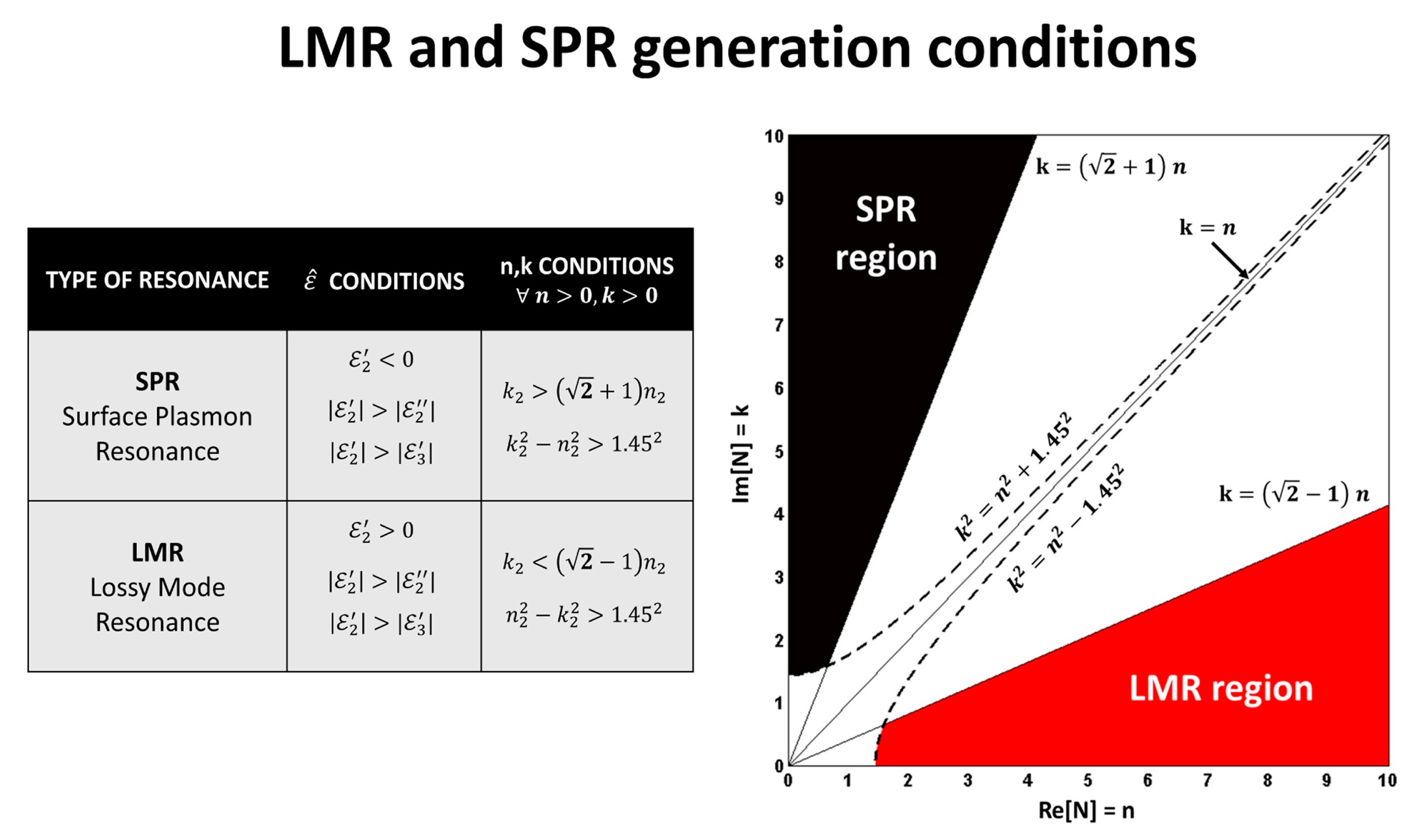

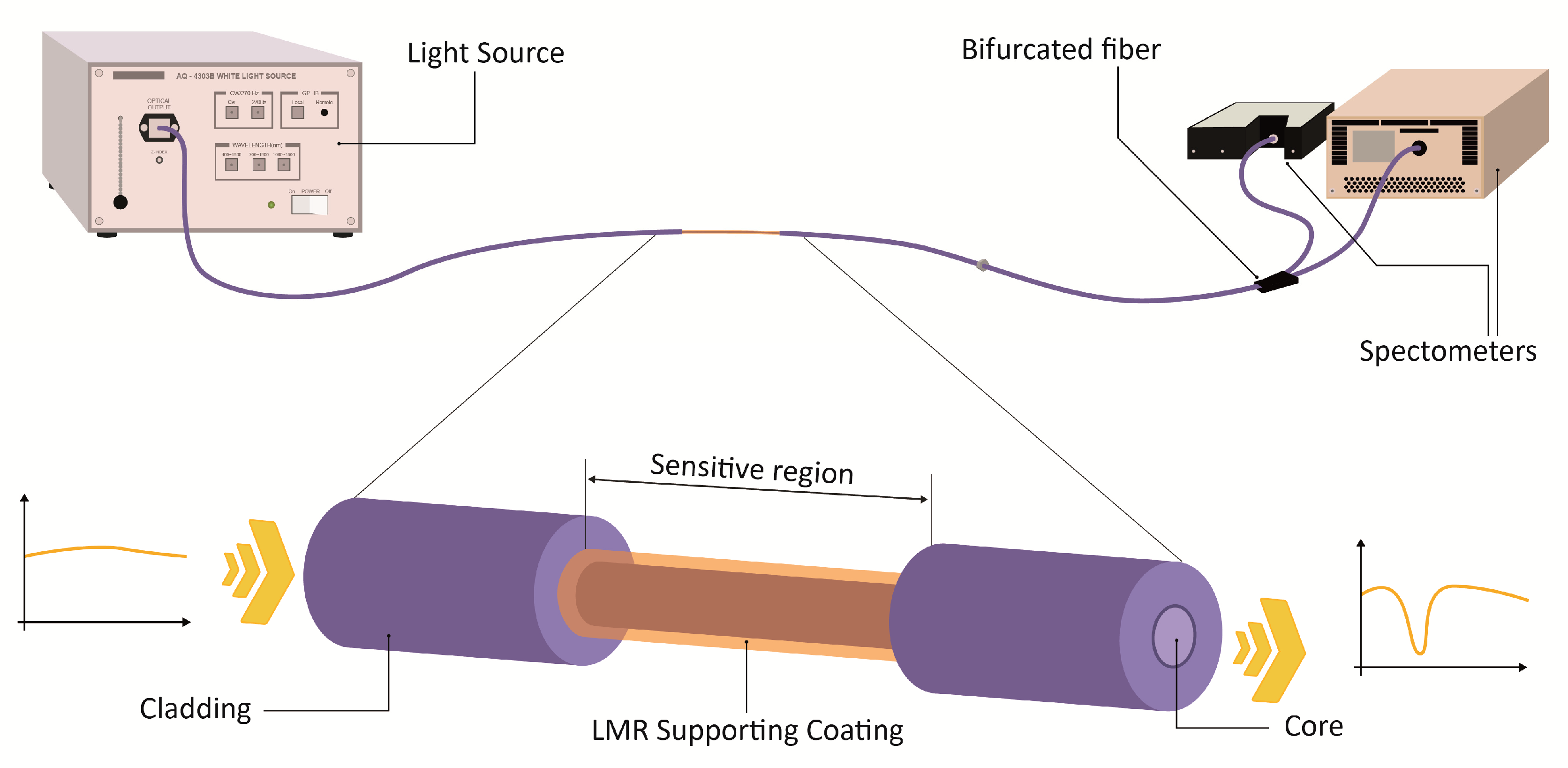
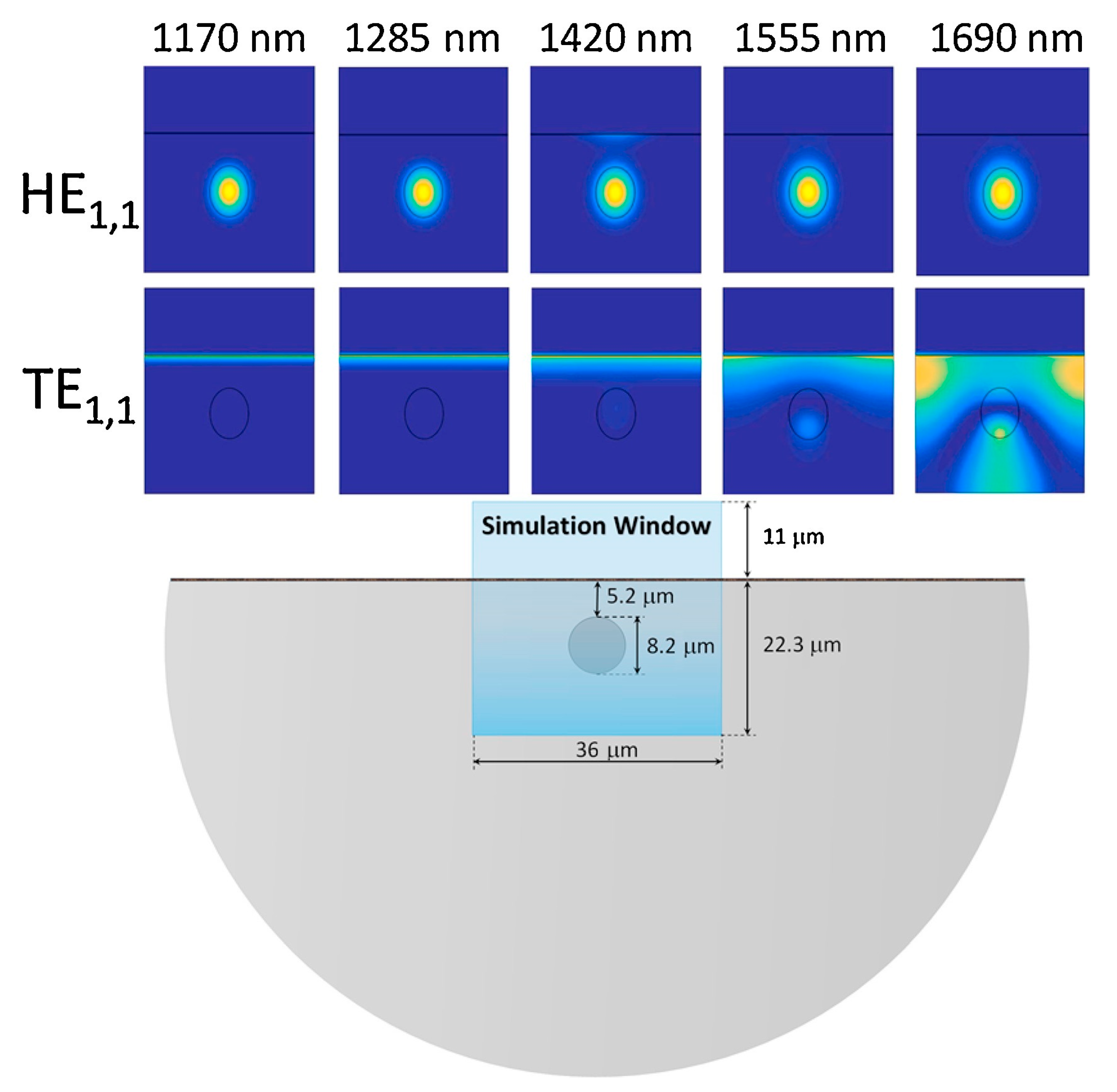
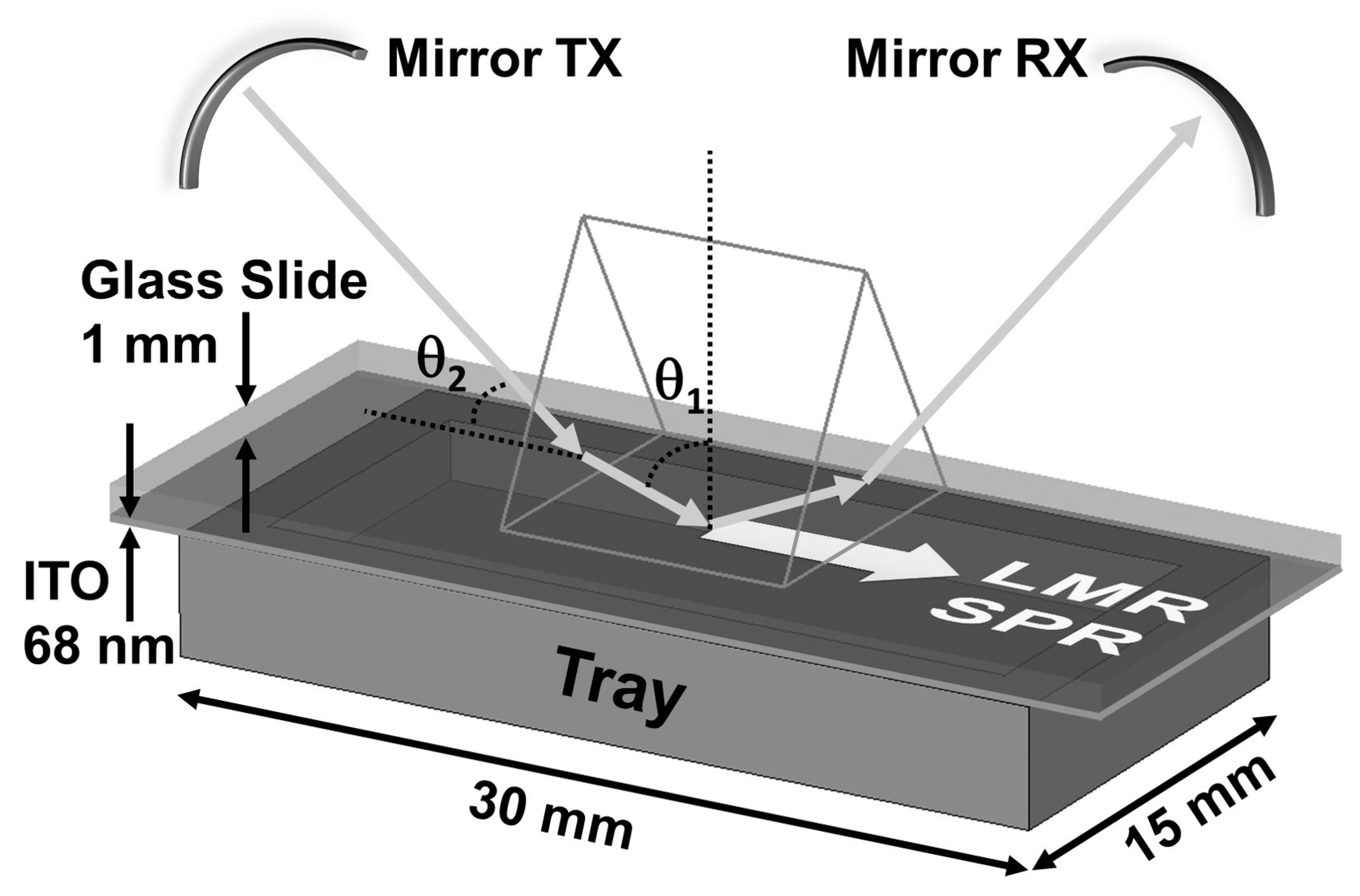
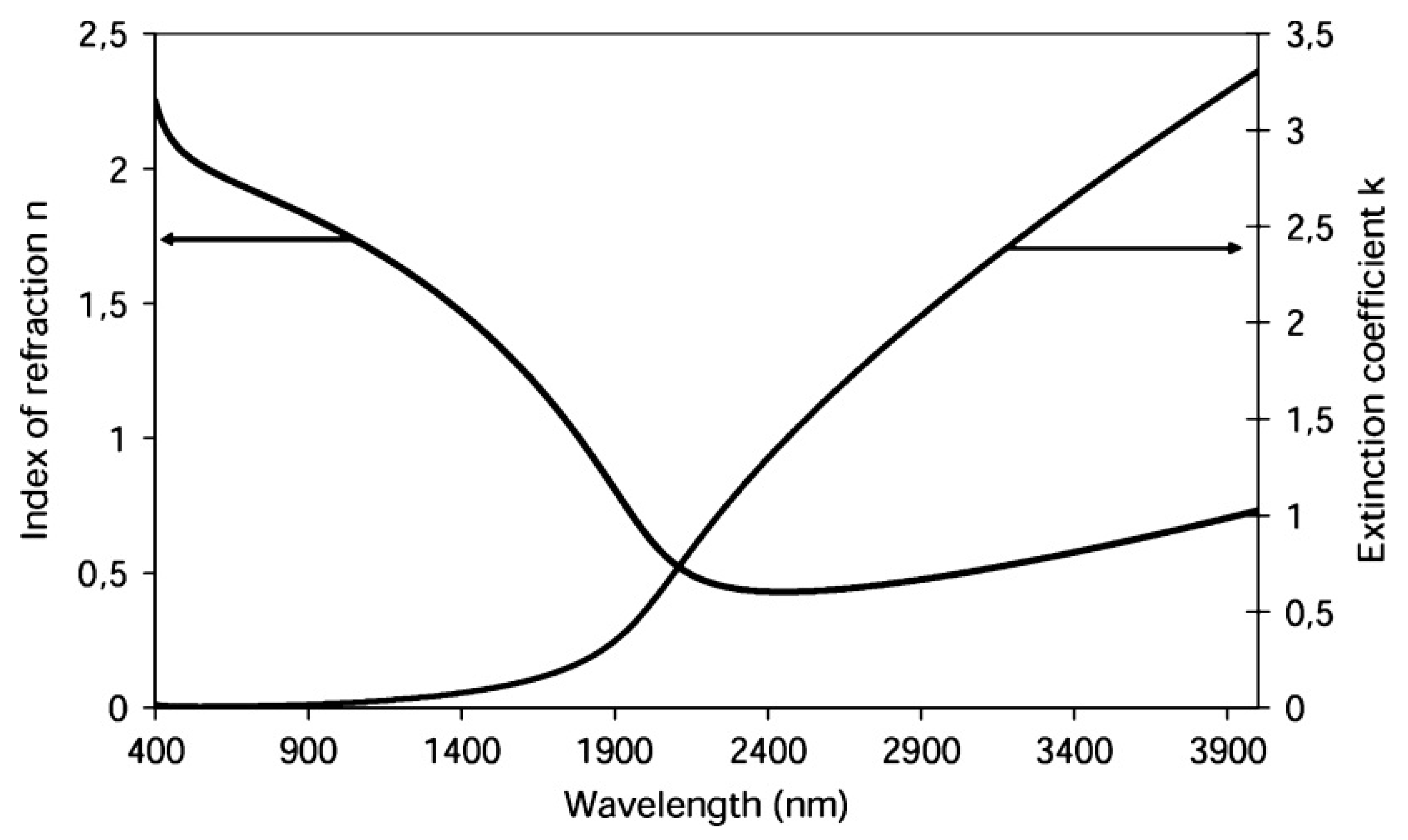
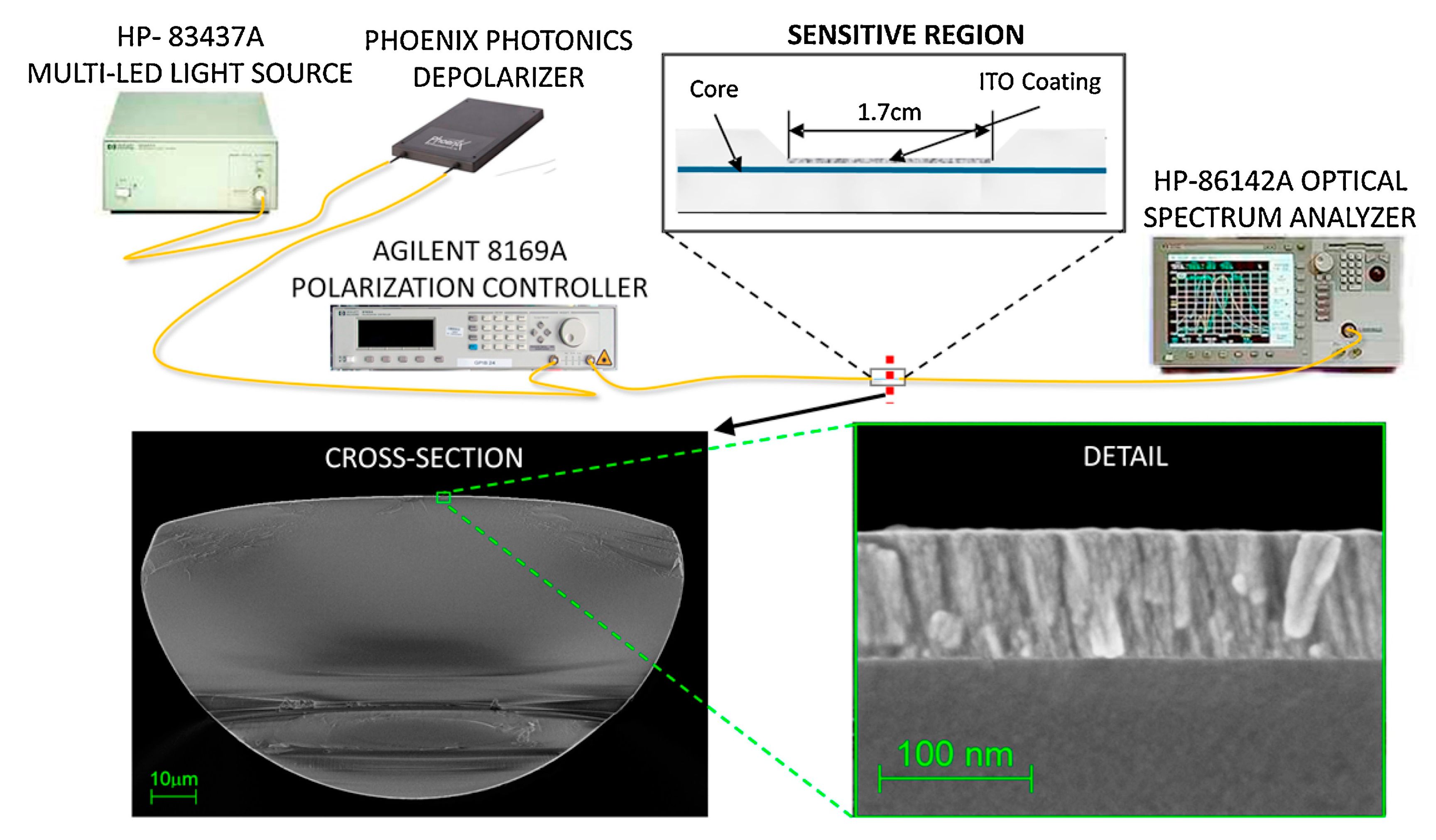
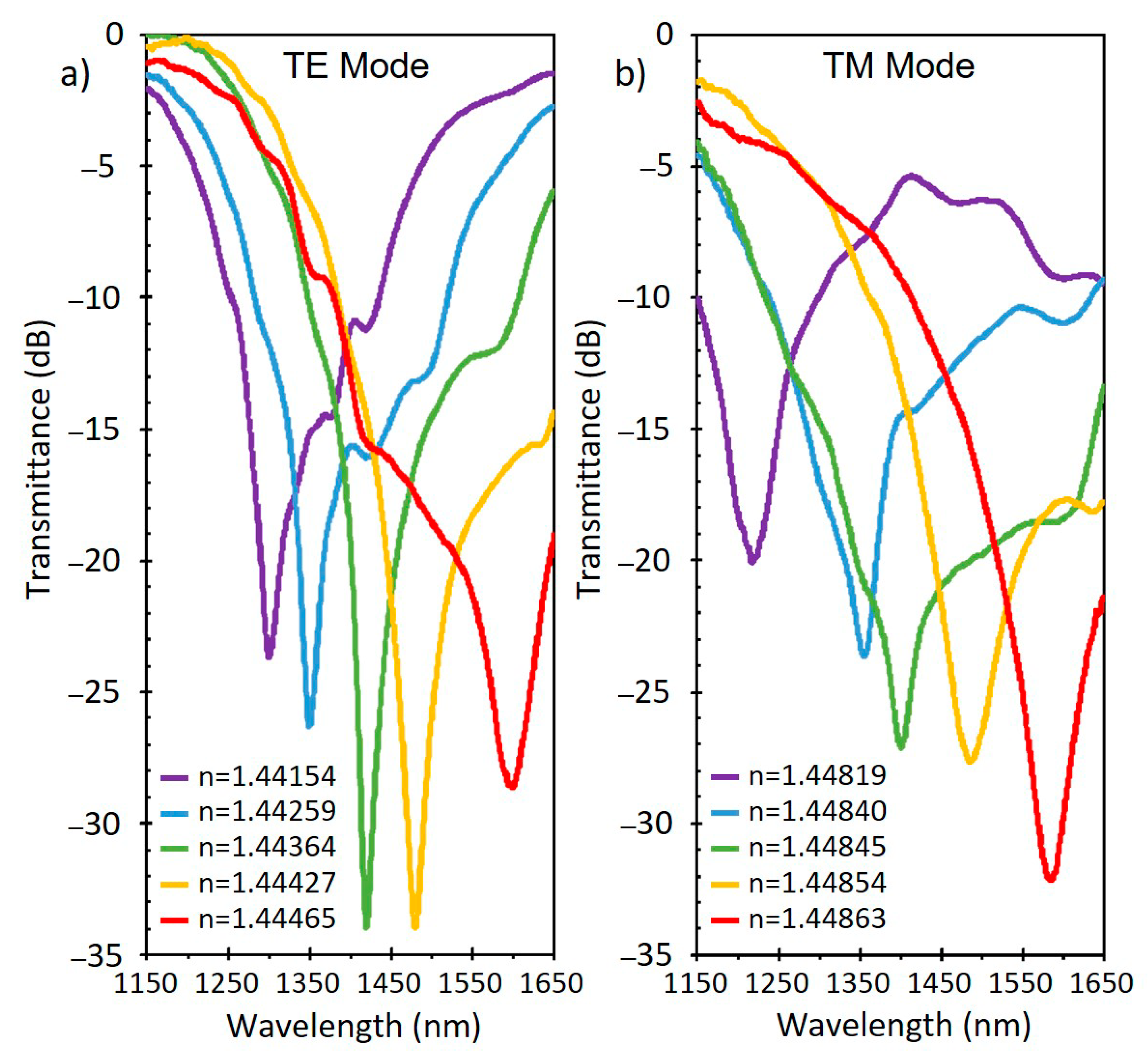
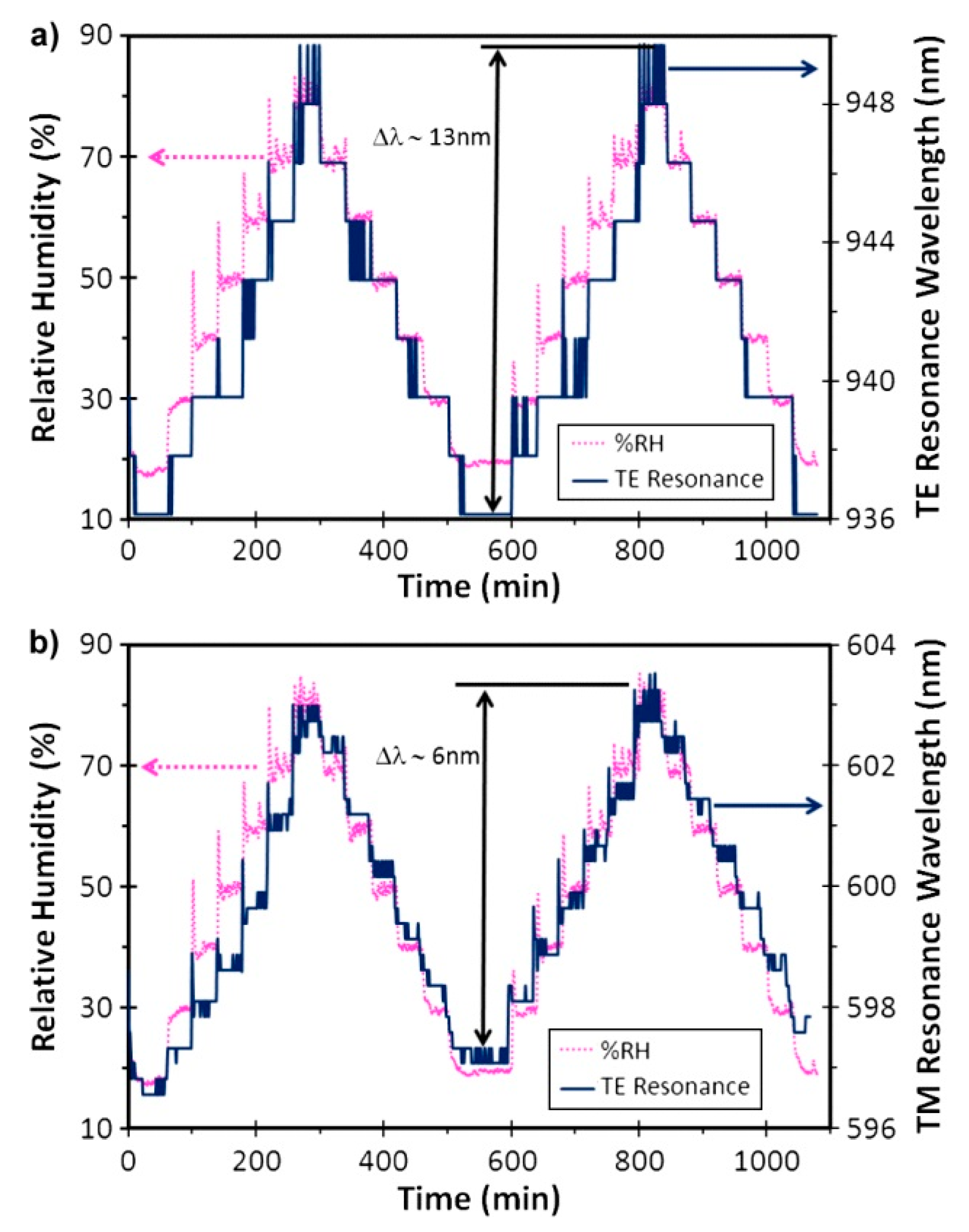

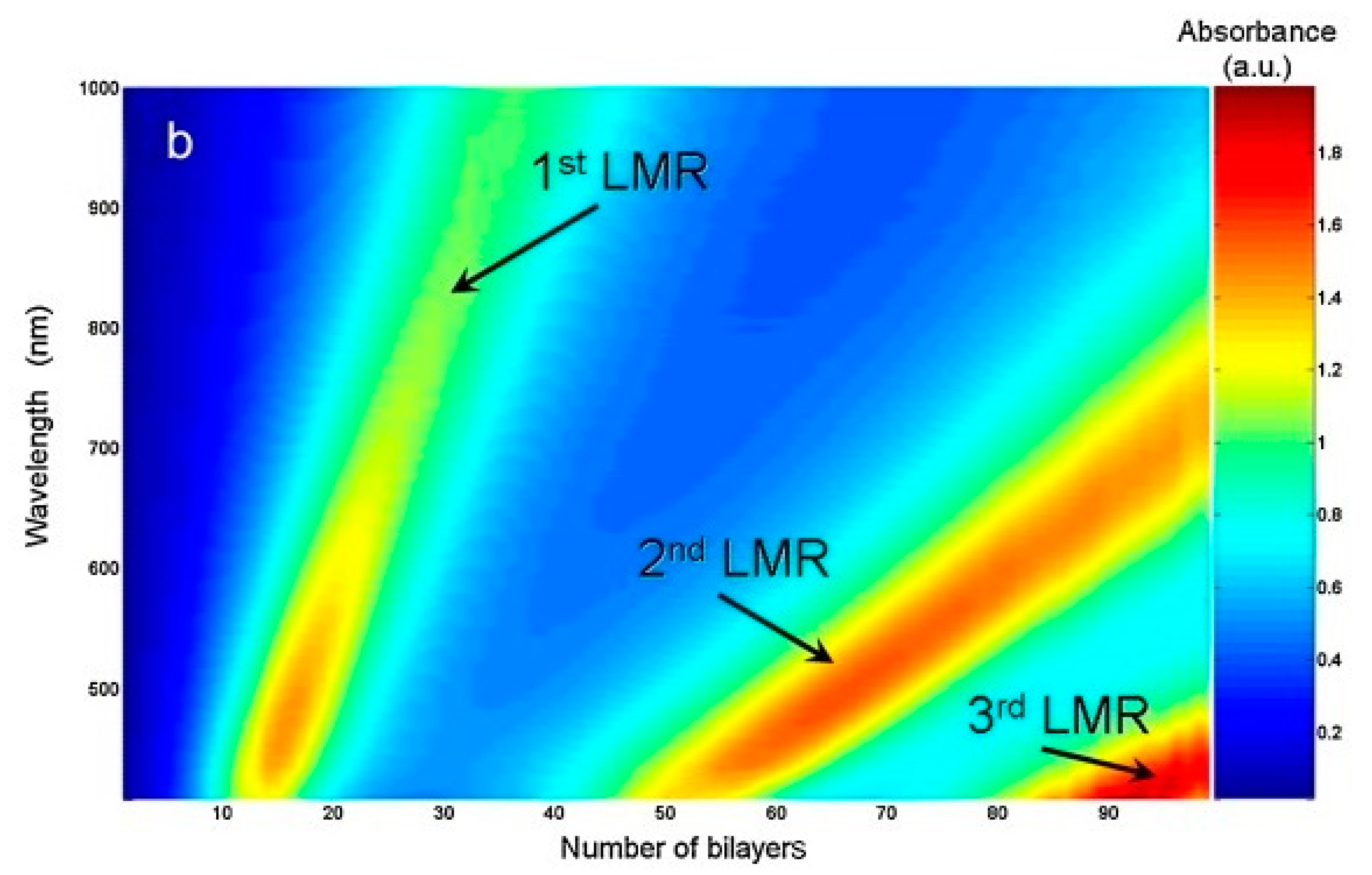
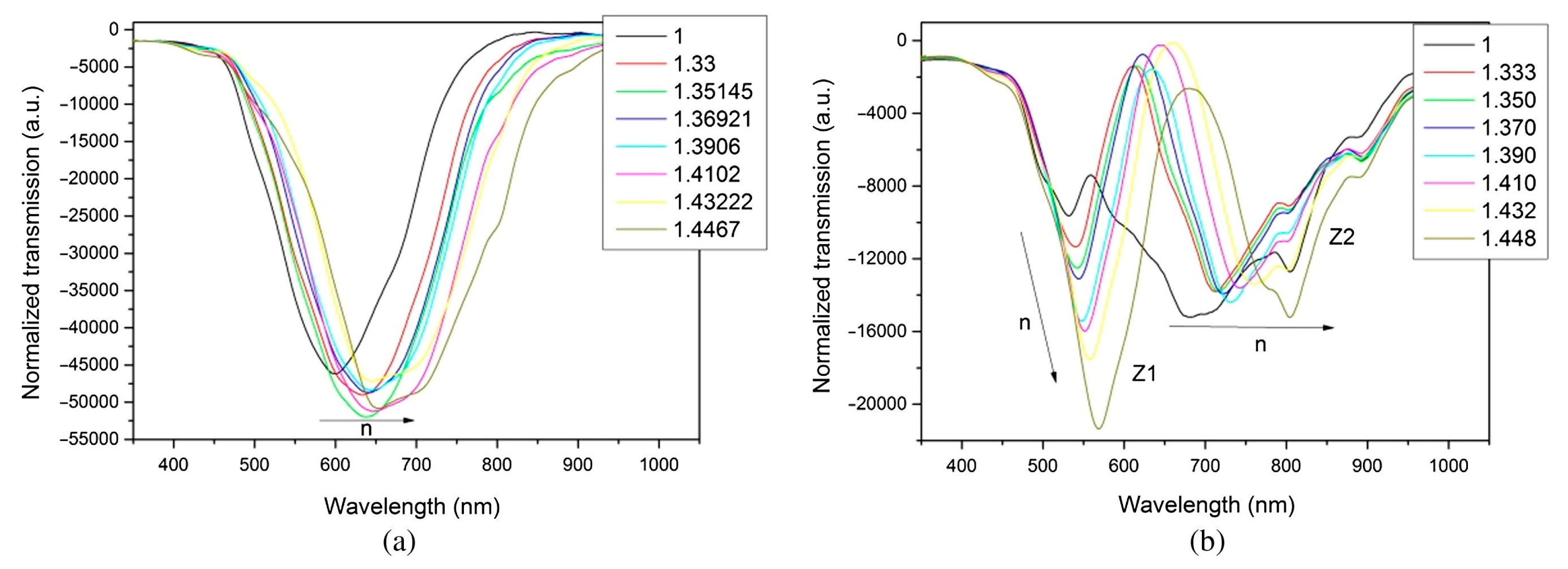
| Material | Configuration | Refractive Index Range | Wavelength | Application/Sensitivity | Ref. |
|---|---|---|---|---|---|
| ITO + PAH–PAA | 200 μm MMF | N/A | 1430 | Relative Humidity: 0.833 nm/%RH | [19] |
| ITO | 200 μm MMF | N/A | 750 | Turbine oil degradation: 0.15 × 10−3 nm/h | [27] |
| ITO | 200 μm MMF | N/A | 550 | Immunoglobulin G LOD: 3.5 μg/L | [29] |
| ITO | 400 μm MMF | N/A | 600 | Ketoprofen: 1400.86 nm/M LOD: 0.536 mM | [20] |
| ITO + ITO NPs | 600 μm MMF | N/A | 400 | H2 Gas: 0.71 nm/ppm | [7] |
| ITO | D-shaped | 1.365–1.38 | 1250 | Refractive Index: 8742 nm/RIU | [28] |
| ITO | D-shaped | 1.447–1.449 | 1280 | Refractive Index: 304,361 nm/RIU | [16] |
| ITO + PAH–PSS | D-shaped | N/A | 1445 | CRP: 10.61–169.93 nm/mg L−1 LOD: 0.0625 mg/L | [21] |
| ITO | Coverslip | 1.33–1.37 | 800 | Refractive Index: 1405 nm/RIU | [25] |
| ITO | Coverslip | N/A | 570 | Relative Humidity: 0.116 nm/%RH | [26] |
| SnO2 | 200 μm MMF | N/A | 1100 | Turbine oil degradation: 0.27 × 10−3 nm/h | [27] |
| SnO2 + GO | 200 μm MMF | N/A | 537 | Ethanol: 0.525 nm/%Eth(v/v) | [37] |
| SnO2–PSS + SnO2 NPs | 600 μm MMF | 1.33–1.38 | 840 | Refractive Index: 4704 nm/RIU | [35] |
| SnO2 | Etched SMF | N/A | 1550 | Relative Humidity: 1.9 nm/%RH | [33] |
| SnO2 NPs + α-Fe@Sn CS | Unclad Fiber | N/A | 370 | Arsenite: 1.31 nm/μg L−1 LOD: 0.99 μg/L | [36] |
| SnO2 | D-shaped | 1.321–1.326 | 1380 | Refractive Index: 14,501 nm/RIU | [16] |
| SnO2 | D-shaped | 1.448–1.449 | 1200 | Refractive Index: 1,087,889 nm/RIU | [32] |
| SnO2 | D-shaped | N/A | 1445 | Immunoglobulin G LOD: 0.15 ng/L | [29] |
| SnO2 | D-shaped | N/A | 1400 | Dimer-D LOD: 10 and 100 ng/mL in buffer and human serum resp. | [34] |
| SnO2 | MCM | N/A | 750 | Immunoglobulin G LOD: 0.6 mg/L | [38] |
| SnO2 | Coverslip | 1.33–1.37 | 900 | Refractive Index: 1800 nm/RIU | [25] |
| In2O3 | 200 μm MMF | 1.32–1.37 | 1400 | Refractive Index: 4926 nm/RIU | [39] |
| In2O3 + PAH–PAA | 200 μm MMF | N/A | 1020 | Relative Humidity: 0.935 nm/%RH | [19] |
| In2O3 | Coverslip | 1.333–1.357 | 730 | Refractive Index: 929 nm/RIU | [40] |
| ZnO | 400 μm U-shaped MMF | 1.33–1.42 | 400 | Refractive Index: 220 nm/RIU | [42] |
| ZnO + ZnO NRs | 400 μm MMF | 1.33–1.44 | 390 | Refractive Index: 1160 nm/RIU | [8] |
| ZnO–MoS2 | 600 μm MMF | N/A | 380 | Urinary p-cresol: 11.86 nm/μM LOD: 28 nM | [44] |
| ZnO + ZnO–PPY | 600 μm MMF | N/A | 400 | Cortisol: 12.86 nm/log (g/mL) LOD: 25.9 fg/mL | [43] |
| ZnO + ZnO nanorods | 600 μm MMF | N/A | 350 | Sulfide gas: 4.14 nm/ppm | [11] |
| ZnO + ZnO NPs | 600 μm MMF | N/A | 370 | Sulfide gas:1.49 nm/ppm | [41] |
| AZO | 200 μm MMF | 1.3334–1.4471 | 1200 | Refractive Index: 1153.6 nm/RIU | [46] |
| AZO | SMS | 1.365–1.405 | 1530 | Refractive Index: 1214.7 nm/RIU | [47] |
| IGZO | D-shaped | 1.39–1.42 | 1150 | Refractive Index: 12,929 nm/RIU | [48] |
| TiO2–PSS | 200 μm MMF | 1.32–1.43 | 1100 | Refractive Index: 2872.73 nm/RIU | [49] |
| TiO2–PSS | 600 μm MMF | 1.33–1.38 | 650 | Refractive Index: 6754 nm/RIU | [50] |
| TiO2 | D-shaped | 1.333–1.398 | 1300 | Refractive Index: 4122 nm/RIU | [51] |
| TMPyP–TiO2 | Tapered SMF | N/A | 850 | Ammonia LOD: 0.16 ppm | [52] |
| PAH–PAA | 200 μm MMF | N/A | 610 | pH (3–6): 36.67 nm/pH | [55] |
| PAH–PAA | D-shaped | N/A | 1397 | pH (4–5): 69 nm/pH | [12] |
| PAH–PAA–AuNP | 200 μm MMF | N/A | 750 | pH (4–6): 67.35 nm/pH | [56] |
| PAH–PAA | 200 μm MMF | N/A | 700 | Relative Humidity: 0.51 nm/%RH | [9] |
| PAH–GNR@PSS | 200 μm MMF | N/A | 850 | Relative Humidity: 11.2 nm/%RH | [58] |
| PAH–PAA–Ag NPs | 200 μm MMF | N/A | 750 | Relative Humidity: 0.943 nm/%RH | [57] |
| Graphene Oxide (GO) | 200 μm MMF | 1.39–1.42 | 550 | Refractive Index: 12,460 nm/RIU | [59] |
| CuO | Coverslip | 1.33–1.37 | 750 | Refractive Index: 1537 nm/RIU | [25] |
| ZrO2 | 400 μm MMF | 1.41–1.43 | 700 | Refractive Index: 880 nm/RIU | [10] |
| SixNy + Ta2O5 | 400 μm MMF | 1.33–1.35 | 770 | Refractive Index: 1077 nm/RIU | [10] |
© 2020 by the authors. Licensee MDPI, Basel, Switzerland. This article is an open access article distributed under the terms and conditions of the Creative Commons Attribution (CC BY) license (http://creativecommons.org/licenses/by/4.0/).
Share and Cite
Ozcariz, A.; Ruiz-Zamarreño, C.; Arregui, F.J. A Comprehensive Review: Materials for the Fabrication of Optical Fiber Refractometers Based on Lossy Mode Resonance. Sensors 2020, 20, 1972. https://doi.org/10.3390/s20071972
Ozcariz A, Ruiz-Zamarreño C, Arregui FJ. A Comprehensive Review: Materials for the Fabrication of Optical Fiber Refractometers Based on Lossy Mode Resonance. Sensors. 2020; 20(7):1972. https://doi.org/10.3390/s20071972
Chicago/Turabian StyleOzcariz, Aritz, Carlos Ruiz-Zamarreño, and Francisco J. Arregui. 2020. "A Comprehensive Review: Materials for the Fabrication of Optical Fiber Refractometers Based on Lossy Mode Resonance" Sensors 20, no. 7: 1972. https://doi.org/10.3390/s20071972
APA StyleOzcariz, A., Ruiz-Zamarreño, C., & Arregui, F. J. (2020). A Comprehensive Review: Materials for the Fabrication of Optical Fiber Refractometers Based on Lossy Mode Resonance. Sensors, 20(7), 1972. https://doi.org/10.3390/s20071972






